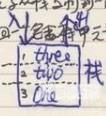一、概述: QueueT队列,对象的先进先出集合(FIFO)。StackT栈,对象的后进先出集合(LIFO)。 QueueT、StackT类似于ListT,但 QueueT没有IListT,所以不能用索引访问队列。也没有实现ICollectionT,无
一、概述:
Queue<T>队列,对象的先进先出集合(“FIFO”)。Stack<T>栈,对象的后进先出集合(”LIFO”)。
Queue<T>、Stack<T>类似于List<T>,但 Queue<T>没有IList<T>,所以不能用索引访问队列。也没有实现ICollection<T>,无Add,Remove等方法。
二、操作
1、入队列:Enqueue()
Queue<string> nums = new Queue<string>();
nums.Enqueue("one");
nums.Enqueue("two");
nums.Enqueue("three");
2、入栈:Push()
Stack<string> nums = new Stack<string>();
nums.Push("one");
nums.Push("two");
nums.Push("three");
3、遍历:队列最先返回最先进的,栈最先返回最后进的元素。
foreach (var num in nums)//队列依次返回,one,two,three ;栈依次返回:three,two,one,
{
Console.WriteLine(num);
}
4、出队列:Dequeue()返回最先进的元素。
Console.WriteLine(nums.Dequeue());//one
5、出栈:Pop()返回最后进的元素。
Console.WriteLine(nums.Pop());//three
6、返回开始处的元素:Peek()
Console.WriteLine(nums.Peek());//two
7、判断是否包含元素:Contains()
Console.WriteLine(nums.Contains("three"));
8、清空队列、栈:Clear()
nums.Clear();
9、队列、栈中元素个数:Count
Console.WriteLine(nums.Count);//0
10、复制到数组:CopyTo()、ToArray()
- CopyTo():把元素从队列复制到一个已有的数组中。
- ToArray():返回一个包含队列元素的新数组。
string[] arr=new string[3]; nums.CopyTo(arr,0); arr= nums.ToArray();
三、示意图


以上就是本文的全部内容,希望对大家的学习有所帮助,也希望大家多多支持自由互联。
